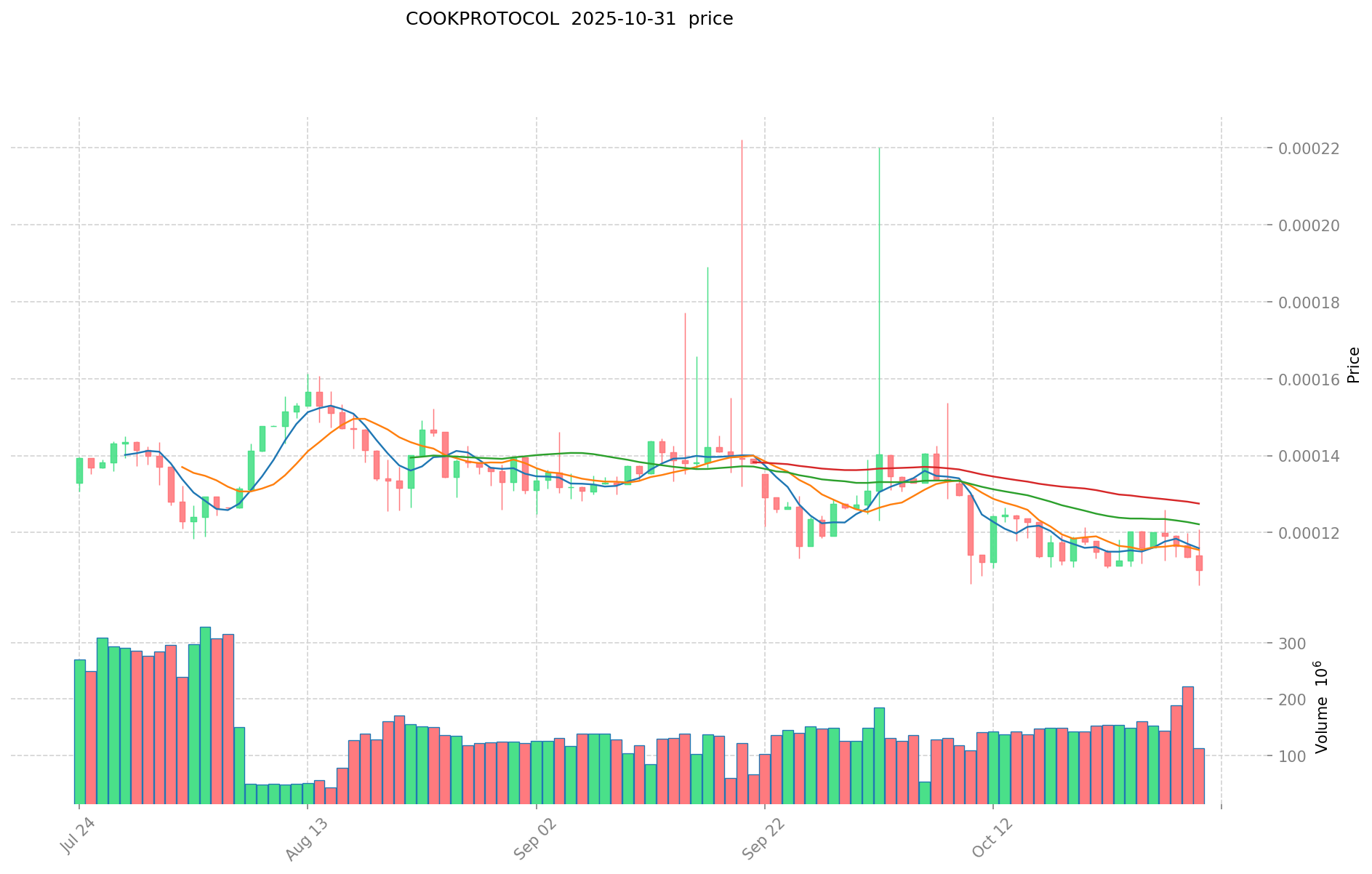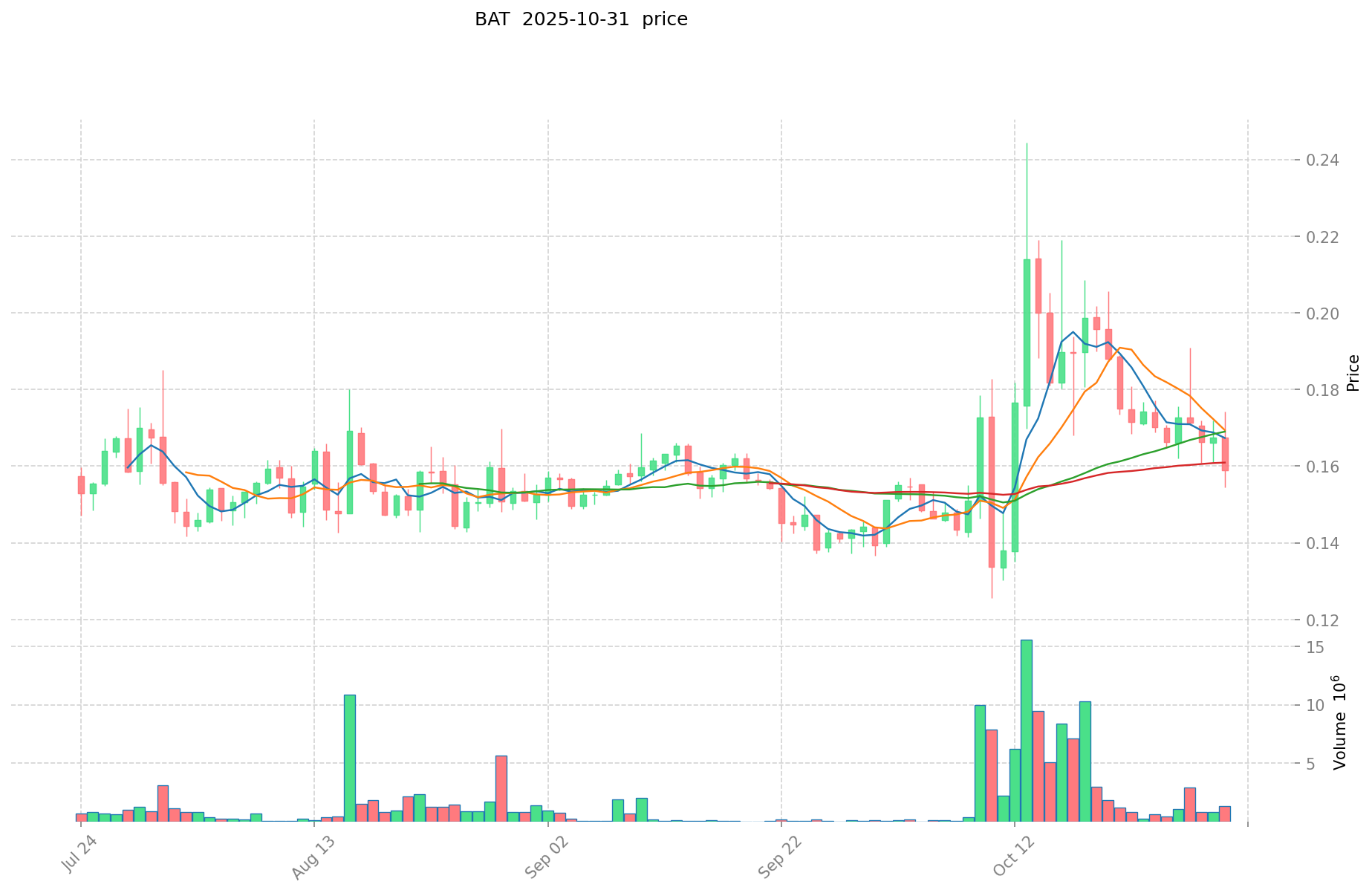COOKPROTOCOL vs BAT: A Comparative Analysis of Decentralized Finance Protocols and Traditional Tech Giants
Introduction: COOKPROTOCOL vs BAT Investment Comparison
In the cryptocurrency market, the comparison between COOKPROTOCOL vs BAT has always been a topic that investors cannot avoid. The two not only have significant differences in market cap ranking, application scenarios, and price performance, but also represent different positioning in crypto assets.
COOKPROTOCOL (COOK): Since its launch in 2021, it has gained market recognition for its decentralized wealth management services.
BAT (BAT): Since its inception in 2017, it has been hailed as a solution for digital advertising, becoming one of the most widely traded cryptocurrencies globally.
This article will provide a comprehensive analysis of the investment value comparison between COOKPROTOCOL vs BAT, focusing on historical price trends, supply mechanisms, institutional adoption, technical ecosystems, and future predictions, attempting to answer the question most concerning investors:
"Which is the better buy right now?" I. Price History Comparison and Current Market Status
COOK (Coin A) and BAT (Coin B) Historical Price Trends
- 2021: BAT reached its all-time high of $1.93900 on November 28, 2021 due to bullish crypto market conditions.
- 2024: COOK hit its all-time low of $0.00000000000903 on April 19, 2024, likely due to broader crypto market downturns.
- Comparative analysis: During the recent market cycles, COOK dropped from its high of $0.376119 to a low of $0.00000000000903, while BAT showed more resilience, maintaining a higher price range.
Current Market Situation (2025-11-01)
- COOK current price: $0.00011445
- BAT current price: $0.1608
- 24-hour trading volume: COOK $9,798.67 vs BAT $104,021.22
- Market Sentiment Index (Fear & Greed Index): 29 (Fear)
Click to view real-time prices:
- View COOK current price Market Price
- View BAT current price Market Price


II. Core Factors Affecting Investment Value of COOKPROTOCOL vs BAT
Supply Mechanism Comparison (Tokenomics)
- COOK: Fixed supply of 100 million tokens with a deflationary model through burn mechanisms
- BAT: Maximum supply of 1.5 billion tokens, with a distribution model focused on users, advertisers, and publishers
- 📌 Historical pattern: Deflationary models like COOK's tend to create upward price pressure when demand increases, while BAT's larger supply with user-focused distribution aims for steady adoption growth.
Institutional Adoption and Market Applications
- Institutional holdings: BAT has attracted more institutional interest due to its established presence in the digital advertising ecosystem
- Enterprise adoption: BAT has stronger integration with the Brave browser and digital advertising platforms, while COOK focuses on DeFi applications
- Regulatory stance: Both tokens face varying regulatory approaches across jurisdictions, with advertising-focused BAT potentially facing less scrutiny than DeFi-focused COOK
Technical Development and Ecosystem Building
- COOK technical upgrades: Implementation of improved yield farming protocols and cross-chain interoperability
- BAT technical development: Enhanced privacy features in the Brave browser ecosystem and expanded reward system
- Ecosystem comparison: BAT has stronger integration in the advertising space with real users, while COOK has more diverse DeFi applications including lending and staking
Macroeconomic Factors and Market Cycles
- Performance during inflation: Both tokens have shown limited correlation with inflation metrics
- Macroeconomic monetary policy: Interest rate changes affect trading volumes for both tokens, with higher rates generally reducing speculative activities
- Geopolitical factors: BAT's advertising model is less affected by cross-border restrictions than COOK's DeFi applications, which may face more regulatory challenges in different jurisdictions
III. 2025-2030 Price Prediction: COOKPROTOCOL vs BAT
Short-term Prediction (2025)
- COOKPROTOCOL: Conservative $0.0000994758 - $0.00011434 | Optimistic $0.00011434 - $0.000148642
- BAT: Conservative $0.133547 - $0.1609 | Optimistic $0.1609 - $0.197907
Mid-term Prediction (2027)
- COOKPROTOCOL may enter a growth phase, with an estimated price range of $0.0000997359235 - $0.00018734180225
- BAT may enter a growth phase, with an estimated price range of $0.13083897255 - $0.28150203185
- Key drivers: Institutional capital inflow, ETF, ecosystem development
Long-term Prediction (2030)
- COOKPROTOCOL: Base scenario $0.000108449938068 - $0.000186982651841 | Optimistic scenario $0.000186982651841 - $0.000258036059541
- BAT: Base scenario $0.29018844412325 - $0.353888346491769 | Optimistic scenario $0.353888346491769 - $0.463593733904217
Disclaimer: This analysis is for informational purposes only and should not be considered as financial advice. Cryptocurrency markets are highly volatile and unpredictable. Always conduct your own research before making any investment decisions.
COOKPROTOCOL:
| 年份 | 预测最高价 | 预测平均价格 | 预测最低价 | 涨跌幅 |
|---|---|---|---|---|
| 2025 | 0.000148642 | 0.00011434 | 0.0000994758 | 0 |
| 2026 | 0.00013806555 | 0.000131491 | 0.00009598843 | 14 |
| 2027 | 0.00018734180225 | 0.000134778275 | 0.0000997359235 | 17 |
| 2028 | 0.000188440245191 | 0.000161060038625 | 0.000151396436307 | 40 |
| 2029 | 0.000199215161775 | 0.000174750141908 | 0.000159022629136 | 52 |
| 2030 | 0.000258036059541 | 0.000186982651841 | 0.000108449938068 | 63 |
BAT:
| 年份 | 预测最高价 | 预测平均价格 | 预测最低价 | 涨跌幅 |
|---|---|---|---|---|
| 2025 | 0.197907 | 0.1609 | 0.133547 | 0 |
| 2026 | 0.217078235 | 0.1794035 | 0.105848065 | 11 |
| 2027 | 0.28150203185 | 0.1982408675 | 0.13083897255 | 23 |
| 2028 | 0.32862388605475 | 0.239871449675 | 0.220681733701 | 49 |
| 2029 | 0.423529025118663 | 0.284247667864875 | 0.201815844184061 | 76 |
| 2030 | 0.463593733904217 | 0.353888346491769 | 0.29018844412325 | 120 |
IV. Investment Strategy Comparison: COOKPROTOCOL vs BAT
Long-term vs Short-term Investment Strategies
- COOKPROTOCOL: Suitable for investors focused on DeFi potential and yield farming opportunities
- BAT: Suitable for investors interested in digital advertising ecosystems and browser-integrated tokens
Risk Management and Asset Allocation
- Conservative investors: COOKPROTOCOL: 20% vs BAT: 80%
- Aggressive investors: COOKPROTOCOL: 40% vs BAT: 60%
- Hedging tools: Stablecoin allocation, options, cross-token portfolio diversification
V. Potential Risk Comparison
Market Risks
- COOKPROTOCOL: High volatility due to lower market cap and trading volume
- BAT: Exposure to fluctuations in digital advertising market trends
Technical Risks
- COOKPROTOCOL: Scalability, network stability in DeFi applications
- BAT: Dependence on Brave browser adoption, potential security vulnerabilities
Regulatory Risks
- Global regulatory policies may have different impacts on both tokens, with DeFi-focused COOKPROTOCOL potentially facing more scrutiny
VI. Conclusion: Which Is the Better Buy?
📌 Investment Value Summary:
- COOKPROTOCOL advantages: Deflationary model, DeFi ecosystem integration, potential for high growth
- BAT advantages: Established user base through Brave browser, digital advertising integration, institutional interest
✅ Investment Advice:
- New investors: Consider a small allocation to BAT as part of a diversified portfolio
- Experienced investors: Balance between COOKPROTOCOL and BAT based on risk tolerance and belief in respective ecosystems
- Institutional investors: Focus on BAT for its more established market presence and potential regulatory advantages
⚠️ Risk Warning: Cryptocurrency markets are highly volatile. This article does not constitute investment advice. None
VII. FAQ
Q1: What are the main differences between COOKPROTOCOL and BAT? A: COOKPROTOCOL focuses on decentralized wealth management services and DeFi applications, while BAT is primarily used in digital advertising and is integrated with the Brave browser. COOKPROTOCOL has a fixed supply of 100 million tokens with a deflationary model, whereas BAT has a maximum supply of 1.5 billion tokens distributed among users, advertisers, and publishers.
Q2: Which token has shown better price performance historically? A: BAT has shown more resilience in price performance. During recent market cycles, COOK dropped significantly from its high of $0.376119 to a low of $0.00000000000903, while BAT maintained a higher price range and reached an all-time high of $1.93900 on November 28, 2021.
Q3: How do the current market situations of COOKPROTOCOL and BAT compare? A: As of November 1, 2025, COOK's price is $0.00011445 with a 24-hour trading volume of $9,798.67, while BAT's price is $0.1608 with a 24-hour trading volume of $104,021.22. BAT has significantly higher trading volume and price.
Q4: What are the key factors affecting the investment value of these tokens? A: Key factors include supply mechanisms, institutional adoption, market applications, technical development, ecosystem building, and macroeconomic factors. BAT has stronger institutional interest and integration with the digital advertising ecosystem, while COOK focuses more on DeFi applications and yield farming opportunities.
Q5: How do the future price predictions for COOKPROTOCOL and BAT compare? A: For 2030, COOKPROTOCOL's base scenario prediction ranges from $0.000108449938068 to $0.000186982651841, with an optimistic scenario up to $0.000258036059541. BAT's base scenario for 2030 ranges from $0.29018844412325 to $0.353888346491769, with an optimistic scenario up to $0.463593733904217. BAT is predicted to have higher absolute prices and potentially larger percentage gains.
Q6: What are the main risks associated with investing in COOKPROTOCOL and BAT? A: COOKPROTOCOL faces higher volatility due to lower market cap and trading volume, as well as potential regulatory scrutiny in the DeFi space. BAT's risks include exposure to fluctuations in the digital advertising market and dependence on Brave browser adoption. Both face general cryptocurrency market risks and potential regulatory challenges.
Q7: Which token is considered a better buy for different types of investors? A: For new investors, BAT is suggested as a small allocation in a diversified portfolio due to its more established presence. Experienced investors might balance between COOKPROTOCOL and BAT based on risk tolerance and ecosystem beliefs. Institutional investors may favor BAT for its established market presence and potential regulatory advantages.
Share
Content